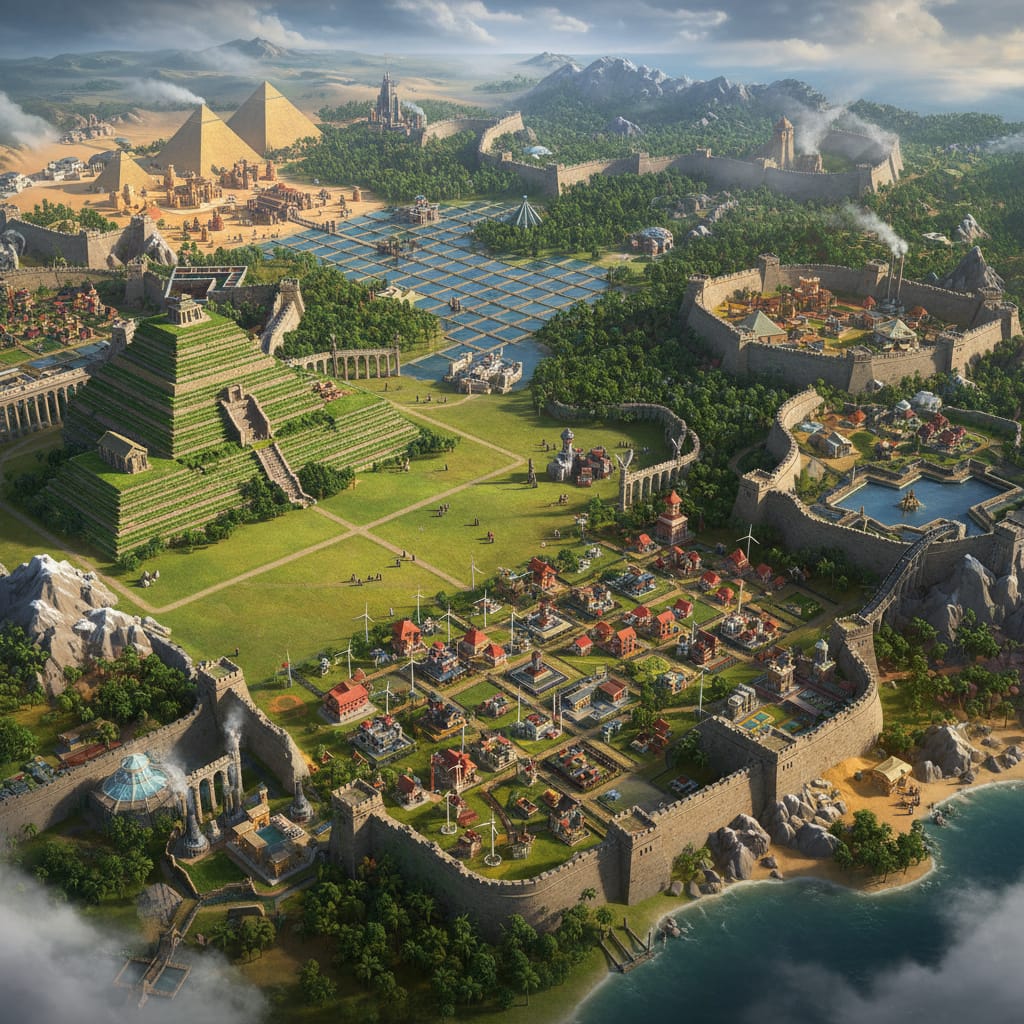A core tenet of Civilization 6 strategy is the art of placement. The decision of where to settle a city, construct a district, or improve a tile is a constant calculation of trade-offs and synergies. Terrain is not merely a decorative backdrop; it is a strategic resource, a puzzle to be solved. Unique Improvements (UIs) are the ultimate expression of this design philosophy, tying a civilization’s identity to the very land it occupies. But what if this fundamental constraint was removed? What if a Builder could place any civilization’s Unique Improvement on any tile, anywhere within their borders?
This hypothetical scenario dismantles one of the game’s central balancing mechanics, unleashing a cascade of strategic consequences that would ripple through every era. The community consensus is clear: such a change, while seemingly offering ultimate freedom, would shatter the game’s delicate equilibrium. Analysis on forums and among professional gamers suggests that the strategic depth gained from careful planning would be replaced by a simplified, and ultimately less rewarding, race to spam the most powerful improvements. This guide explores the profound strategic shifts that would occur, analyzing which civilizations would skyrocket to dominance, which would falter, and how the very nature of gameplay would be irrevocably altered.
The End of Situational Strategy: A New Tier List Emerges
The most immediate and dramatic impact would be the homogenization of strategy. Currently, the strength of a Unique Improvement is intrinsically linked to its placement requirements. The challenge of finding the perfect spot for a Dutch Polder or an Incan Terrace Farm is a key part of their power. Remove that challenge, and a new, more rigid hierarchy of UIs would instantly emerge, based solely on their raw yields and adjacency bonuses.
The God-Tiers: Universal Yield Machines
Certain civilizations would become almost unrecognizable in their power, their UIs transforming from situational assets into universally applicable engines of growth.
Inca: The Inca, already a powerhouse in mountainous regions, would ascend to a new level of dominance. According to player community analysis, Terrace Farms are arguably the best UI in the game, balanced only by their requirement for hill tiles. If they could be built on flat grasslands, plains, or even desert, the result would be a civilization with virtually no geographical constraints on its growth. Imagine sprawling Incan cities, not just nestled in mountain ranges, but covering entire continents with high-yield farms, each providing massive amounts of food and production, especially when placed next to each other. The adjacency bonuses, currently a reward for clever placement, would become a standard feature of every tile.
Netherlands: The Dutch Polder is a testament to the power of turning marginal land into a goldmine. Its strict placement requirements—coastal tiles, marsh, or floodplain—are the only thing holding back its incredible yields of food, production, and gold. A popular strategy is to seek out low-lying coastal areas to maximize their potential. If Polders could be built on any tile, the Netherlands would possess the single most powerful general-purpose improvement in the game. Every tile in their empire could become a source of immense wealth and productivity, fueling an unstoppable economic and scientific machine.
Australia: The Outback Station is another UI balanced by its terrain requirements. It provides food and production, with significant bonuses for adjacent pastures. If this restriction were lifted, Australia could blanket its territory with these improvements, creating an industrial behemoth. The “culture bomb” effect of the Outback Station would also become far more potent, allowing for rapid and aggressive territorial expansion on any terrain.
The Rise of the Economic Juggernauts
Other civilizations, while perhaps not reaching the same level of absurdity as the Inca or the Dutch, would still experience a massive surge in power.
Gran Colombia: The Hacienda is already a strong UI, providing production, gold, and housing. Its true power, however, is unlocked by its adjacency bonuses with plantations and other Haciendas. In a world without placement restrictions, Gran Colombia could create vast, interconnected networks of Haciendas, generating staggering amounts of gold and production. This would allow them to field their powerful unique units even more effectively, overwhelming their opponents with a tide of steel and gold.
Indonesia: The Kampung is a unique improvement that turns coastal tiles into vibrant hubs of food, housing, and production. If it could be built inland, any Indonesian city, regardless of its proximity to the sea, could become a population and cultural powerhouse. The strategic trade-off of settling on the coast versus inland would be eliminated, giving Indonesia unparalleled flexibility in its expansion.
Devaluation of Terrain: A Flatter, Less Interesting World
A less obvious, but equally profound, consequence of this change would be the devaluation of terrain itself. The unique geographical features of the map—mountains, deserts, rivers, and coastlines—would lose much of their strategic significance.
The Mountain Becomes a Molehill
Mountains, currently a defining feature of the map, would be reduced to mere obstacles. For the Inca, they would no longer be the source of their strength, but simply a tile like any other. The strategic challenge of navigating and utilizing mountainous terrain would be gone, replaced by a uniform landscape of high-yield improvements.
The Desert Loses its Sting
Civilizations like Nubia and Egypt, which have unique advantages in the desert, would see their identities diminished. The Nubian Pyramid, which makes desert tiles viable and even desirable, would lose its purpose if it could be built on lush grasslands. The Sphinx, which gains bonuses from being on floodplains, would be just as effective on a barren tundra tile. The strategic niche of these civilizations would be eroded, pushing them towards the same homogenized strategies as everyone else.
The New Calculus of War and Defense
The ability to build any UI anywhere would also have a significant impact on military strategy and defense.
The Great Wall of Everywhere
China’s Great Wall is a unique improvement that provides gold, culture, and a defensive bonus. Its placement is restricted to the borders of your territory. If this restriction were removed, China could build a wall not just on its borders, but throughout its empire, creating a defensive labyrinth of unprecedented scale. Every tile could be a fortified position, generating income and culture while slowing enemy advances to a crawl.
The Fortress Empire
Other defensive UIs, like the Roman Fort and the Māori Pā, would also become far more powerful. The ability to place a fort on any tile would allow for the creation of deeply fortified empires, making offensive warfare a costly and difficult proposition. The strategic decision of where to place a fort would be replaced by the simple act of spamming them wherever there is empty space.
The Ripple Effect: Unintended Consequences
The changes described above would have a number of ripple effects, altering the balance of the game in ways that might not be immediately obvious.
The Amenity Crisis Solved
Many UIs provide amenities, which are crucial for keeping your population happy and productive. The Aztec Tlachtli, for example, provides amenities and faith. If it could be built anywhere, the challenge of managing amenities would be greatly reduced. Civilizations with amenity-providing UIs would have a significant advantage, able to grow their cities larger and faster without fear of rebellion.
The End of the Specialist
Many civilizations are designed to be specialists, excelling in a particular area of the game. The Spanish, with their Mission UI, are geared towards a religious victory. The French, with their Château, are focused on culture. In a world of universal UIs, this specialization would be less important. The raw power of the top-tier UIs would be so overwhelming that they would be the optimal choice for any victory condition. The strategic diversity of the game would be lost, replaced by a single, dominant strategy.
A World of Broken Possibilities
The hypothetical scenario of builders being able to construct any Unique Improvement on any tile is a fascinating thought experiment that reveals the elegant design of Civilization 6’s core mechanics. While the idea of unrestricted freedom might seem appealing, the reality is that it would lead to a less interesting, less balanced, and ultimately less rewarding game. The strategic depth of the game comes from its constraints, from the challenge of working with the hand you’re dealt. By removing one of the most important constraints, you don’t create a world of infinite possibilities, but rather a world where only one possibility matters: the one that gives you the most of everything, everywhere, all at once. The community’s analysis is spot on: it would be a world of broken, beautiful, and utterly unbalanced possibilities.


